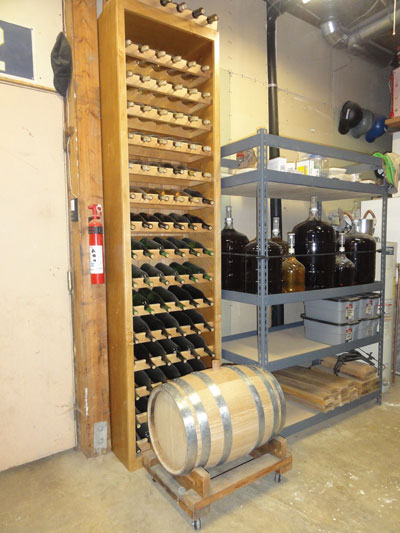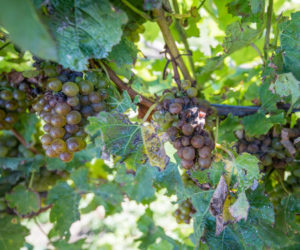
Many homemade wines are fermented to drink young. They may be white wines, rosés, or light, fruity reds. They have bright, crisp flavors and are sometimes made in an off-dry style. When I make wines like that, I start drinking them within a year. Sometimes, though, we want to craft a wine for the ages. Usually big, bold reds, these wines tend to be full-bodied, tannic, deeply colored, starting as red or purple and turning brick or tile-colored as they age. If not a big red, an age-worthy wine may be Port-style, Sherry, or late harvest, including white varieties.
In Concepts in Wine Chemistry, author Yair Margalit, Ph.D., says, “One of the main quality characteristics of wine varieties is their potential to age well.” This means wines that improve, at least for a while, with time in the cellar. Unlike early drinking wines, these are wines to keep around for years or decades. The preferences of wine drinkers differ and the nuances of a well-aged, brick-hued Cabernet Sauvignon that please one wine lover might just seem tired and lacking in fruit to another. Home winemaking objectives come in many forms. Some may include simply making enough wine so the cellar never runs empty. Another may be making wine from your own vineyard, vintage after vintage, to observe how it evolves. If you decide to emulate the great age-worthy wines, there are techniques to help you get there.
Wine aging chemistry is mostly about polyphenolics. Two broad classes of these compounds in grapes and wine are anthocyanins and tannins. Other factors that affect ageability include alcohol, sulfur dioxide, pH, other reducing agents, and storage conditions. The polyphenolic compounds share a basic building block, phenol, which is a type of six-carbon ring (known as an “aromatic ring” in organic chemistry). In plants and fruits, polyphenolics often confer protection from pests or accommodation to adverse environmental conditions. In grapes, the anthocyanins and related flavonoids help confer protection from excessive sunlight. Since these compounds go on protecting wine from oxidation during aging, it makes sense that you want dark, well-ripened fruit to ferment into age-worthy wine. Over time, the anthocyanin pigment molecules in wine combine with tannins to form the “brick red” compounds that are indicative of a long wine life.
The other chemical partners, the tannins, need to be present for long aging as well. These compounds are similar to (or the same as) various materials used for tanning animal hides. They bind with and precipitate proteins, making them less water soluble — in tanning, turning skin into leather. In wine, they provide the tannic “grip” of red wine on your palate. Like the anthocyanins, they develop in grapes during growth and development, probably providing some protection against damage by insects and predators. As harvest approaches, the tannins “mellow” and become less harsh tasting.
In a grape crop, about 60% of the total tannin content is in the seeds. Another 20% is in the stems, 16% in the leaves, and only about 4% in the skins. Juice and pulp contain very little tannin. Since the anthocyanins are concentrated in the colored skin, fermenting on skins and seeds introduces most polyphenolics in red wine. Cautions against breaking seeds can be explained by the possible doubling or tripling of the tannin load if the seed tannins are easily extractable. Tannins provide structure to a wine’s mouthfeel and help balance any possible sweetness from residual sugars or even from ethanol. They help avoid an overly soft or “flabby” character in the wine. In supporting aging well, they condense with anthocyanins to stabilize color. They also act as antioxidants, fighting premature spoilage and oxidation.
Throughout the development of your wine, you have opportunities to maximize your tannin profile for aging. There are steps to be taken in the vineyard if you grow your own grapes. After that, you can make improvements at crushing, during vinification, during bulk aging, and while cellaring. In the vineyard, sun exposure is your best friend. Your trellising plan and leaf-pulling program should leave you with about 1½ layers of leaves between direct sunlight and your grapes. In his handbook Sunlight into Wine, Dr. Richard Smart describes several techniques for assessing sun exposure on ripening fruit. You may need to change your trellising or pruning practices, pull leaves, or drop fruit to bring the crop in balance with what your vines can do. You want to harvest deeply colored fruit with very uniform ripeness.
Wine aging chemistry is mostly about polyphenolics.
At crush, you need to tear the grape skins to release anthocyanins and tannins. Include the seeds, but avoid breaking them. Exclude stems and leaves. Although they contain tannins, they also contain vegetative matter that may cause green, vegetal flavors in your wine. If stems are very well developed and brown (lignified), you may consider adding back up to about 10% of them as a “wood” contribution during fermentation. If green and flexible, leave them out.
Cold soaking of crushed grapes before initiating fermentation may lead to better color extraction. During primary fermentation, punching down the cap at least twice a day will help with tannins and anthocyanins — consider three or four times a day if you are targeting an age-worthy wine. If you have the facilities and equipment for it, you may want to try rack-and-return (delestage) instead of punchdowns. In rack-and-return, the fermenting wine is drained from a lower valve, usually through a sieve that collects seeds. The wine is then rapidly poured back over the cap, breaking it up. Tasting regularly, you may return the seeds for more extraction at the same time, or remove them to avoid further harshness. Extended maceration — holding the wine in the fermenter after primary is done — exposes remaining skins and seeds to an alcoholic soak that may extract more polyphenolics. Less common techniques for improved extraction include pumpovers, submerged cap fermentations, or rotary fermenters. These require more advanced equipment than basic home winemaking and are found mostly in commercial settings, but you can certainly try them if you are interested.
Another technique to improve color stability and age worthiness is to add oxygen early in your red wine fermentation. Aerative punchdowns where you splash the wine each time you lift the punchdown tool are easy and low-tech. Oxygen added at this stage strengthens the growing yeast colonies and helps tannins condense with anthocyanins. You may want to consider some additions for better color and stability. Of course, blending in a highly colored or tannic wine like Petite Sirah or Alicante Bouschet will alter the contours of a light red wine. Less obviously, you can make a rosé during the same vintage and add back the pressed red skins to your red ferment. You can even freeze the skins for a while if rosé-pressing day does not line up with red crush day. Even white grape skins, pressed from juice, can be added to a red primary to help stabilize tannins and colors. For my homegrown Pinot Noir, I sometimes achieve skin “addition” to the red wine by removing some pink juice. After an overnight soak on the skins, I plunge in a perforated stainless steel strainer, scoop out some 10% of the juice, and fill a carboy to make a saignée rosé. That leaves the red wine fermentation 10% stronger in skins and seeds.
Finally, you can add exogenous tannins. If your red wine is likely to come up too light and thin for long aging, consider what source you want for added tannins, when you want to add them, and then do it. Oak is the traditional choice and you can begin by adding oak chips to the primary fermentation. These may be neutral or toasted, depending on what you want to do with your flavor profile. The next stage is bulk aging, where oak barrels are the best choice if you can manage the volume. In addition to adding oak tannins, barrels facilitate a low transfer of oxygen to the aging wine to help condense tannin polymers. Other oak products such as sticks, staves, spirals, or beans can add tannins, but they do not contribute oxygen stability like barrels do. If you get close to bottling and still need a tannic boost, you can use liquid or powdered oak extract products. Beyond oak, there are tannin addition products made from woods like Quebracho, oak gall nuts, and even citrus wood.
Other aging influences are also working during bulk storage. Sulfite is acting to prevent microbial spoilage and retard oxidation. Alcohol helps inhibit microbial spoilage. Other reducing agents like volatile reduced sulfur compounds (VRS) can extend aging by scavenging oxygen from the wine. They may age out and resolve nicely, but they may not — leaving the wine with an off-odor. Steady, fairly low cellar temperatures will facilitate long-term aging by slowing and moderating all of its effects. While 55 °F (13 °C) is considered ideal, avoiding heat spikes or fluctuations is more important than a specific temperature.
Some wines are inherently ageable. Port-style wines are traditionally made by adding alcohol and sulfite to a partially completed red wine fermentation. The high alcohol level stabilizes the wine against spoilage. If allowed deliberate oxygen exposure in barrel, Port develops brick-red colors and are called “tawny.” That wine is resistant to degradation for decades. Many Sherries, and wines like Marsala and Madeira, are also allowed to oxidize in bulk storage and are very stable after bottling. All of these share aspects of brownish colors and nutty, savory (umami), or caramelized aromas and flavors. Late harvest wines, very high in residual sugar, also age extremely well. Usually considered dessert wines, many are high in alcohol and show signs of oxidation.
To make your wine age-worthy, maximize polyphenolics in the vineyard. Extract them effectively into the wine. Add more skins or tannins if you need to, from one or more sources. Stabilize the resulting reaction products. Then take care of your pampered beverage as it spends years aging toward its own perfection.






